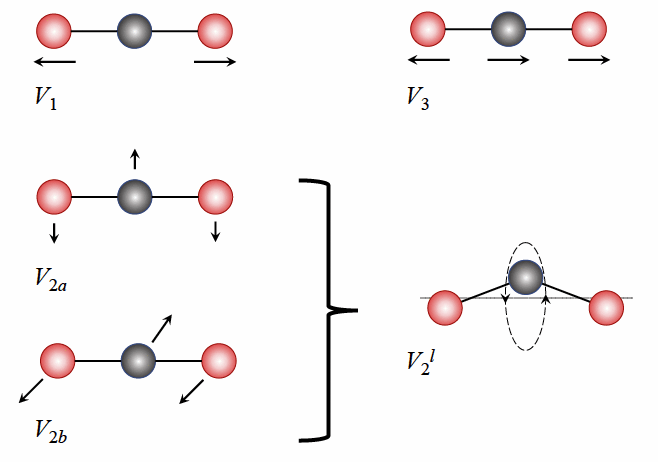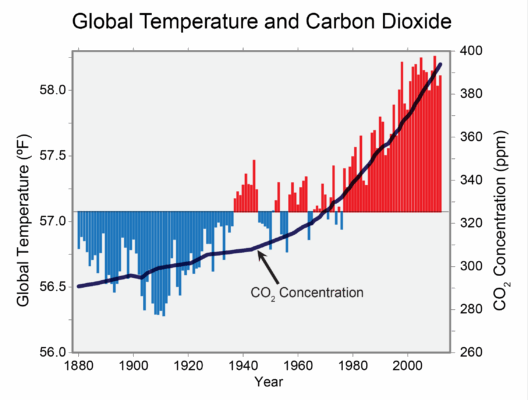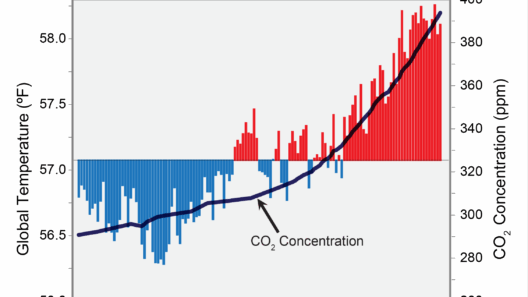Understanding the intricate dynamics of climate change necessitates an exploration of molecular interactions and their consequences on global temperatures. Notably, the bending vibrations of greenhouse gases, particular to molecules like carbon dioxide, play a significant role in atmospheric heating. But how exactly do these vibrations contribute to global warming? This inquiry leads us into a deeper examination of molecular structure, vibrational modes, and their resonance with electromagnetic radiation.
At the heart of the climate change tumultuous debate lies the concept of greenhouse gases. These gases possess the unique capacity to absorb and emit infrared radiation, a phenomenon that is pivotal in trapping heat within the Earth’s atmosphere. Carbon dioxide (CO2), methane (CH4), and nitrous oxide (N2O) are the most influential among these, possessing distinct vibrational characteristics. In particular, the bending vibrations of these molecules contribute to their ability to capture thermal energy.
The molecular geometry of carbon dioxide is linear, consisting of a central carbon atom flanked by two oxygen atoms. At ambient conditions, CO2 exhibits two primary types of vibrational modes: symmetric stretching and bending vibrations. The bending vibration occurs when the angle between the bonds of the molecule alters while keeping the bond lengths constant. This is a crucial aspect because, during bending, the dipole moment changes, allowing the molecule to interact with infrared radiation effectively.
The bending vibration of CO2 occurs at a frequency that aligns well with infrared radiation emitted by the Earth. When the Earth’s surface absorbs solar energy, it re-emits this energy as infrared radiation. CO2, through its bending vibrations, can absorb this radiation and re-radiate it in all directions, a phenomenon known as the greenhouse effect. This effect warms the atmosphere and contributes to rising global temperatures.
The implications of these molecular interactions extend beyond mere temperature increases. The accumulation of CO2 in the atmosphere, primarily due to fossil fuel combustion, deforestation, and industrial processes, has been steadily increasing since the Industrial Revolution. Consequently, the concentration of CO2 has surpassed 400 parts per million, marking a significant departure from pre-industrial levels. This elevation in concentration magnifies the bending vibrations, leading to enhanced heat retention.
Methane, another potent greenhouse gas, exhibits even more complex vibrational behavior. The molecular structure of methane is tetrahedral, allowing for multiple vibrational modes including bending, asymmetric stretching, and symmetric stretching. Methane’s bending vibrations also resonate within the infrared spectrum, and its global warming potential is approximately 25 times greater than that of CO2 over a century. This means that even small increases in methane emissions can have disproportionate effects on global warming.
While the bending vibrations of these gases are critical, their effects can be exacerbated by feedback mechanisms in climate systems. For instance, as the temperature rises due to greenhouse gas emissions, various natural processes are activated. Melting ice caps lead to reduced albedo, which in turn accelerates heating. Similarly, warming oceans can yield more water vapor, a greenhouse gas itself, ultimately enhancing the initial warming effect caused by bending vibrations.
The role of bending vibrations in global warming reveals much about the interconnectedness of molecular chemistry and environmental science. Advances in spectroscopy and molecular modeling provide powerful tools for researchers to visualize and quantify these interactions in real-time, yielding insights that can inform climate policy and mitigation strategies. For example, capturing and sequestering carbon emissions can directly mitigate the impact of bending vibrations of CO2.
Moreover, innovations in green technologies, such as renewable energy sources and carbon capture techniques, are crucial in addressing the prevalent challenges posed by greenhouse gas emissions. Through the application of environmentally friendly practices, society can aim to reduce the concentration of CO2 and other greenhouse gases, consequently diminishing their bending vibration-induced impacts on the atmosphere.
Public awareness and education about the mechanics of climate change are paramount. Understanding how seemingly abstract molecular vibrations have tangible consequences on the planet’s climate can empower individuals to advocate for sustainable practices. Individuals can engage in activities such as reducing personal carbon footprints, supporting renewable energy initiatives, or participating in local conservation efforts to combat the pervasive effects of global warming.
In conclusion, the intricate relationship between bending vibrations in greenhouse gases and global warming underscores a fundamental aspect of climate science. As these molecules vibrate and interact with radiation, they play a critical role in trapping heat within our atmosphere, driving the urgent need for comprehensive climate action. As scientists continue to unravel the complexity of these interactions, there is an ever-growing imperative for society to act upon this knowledge—to reduce emissions, embrace sustainable technologies, and work toward a resilient planet for future generations.








